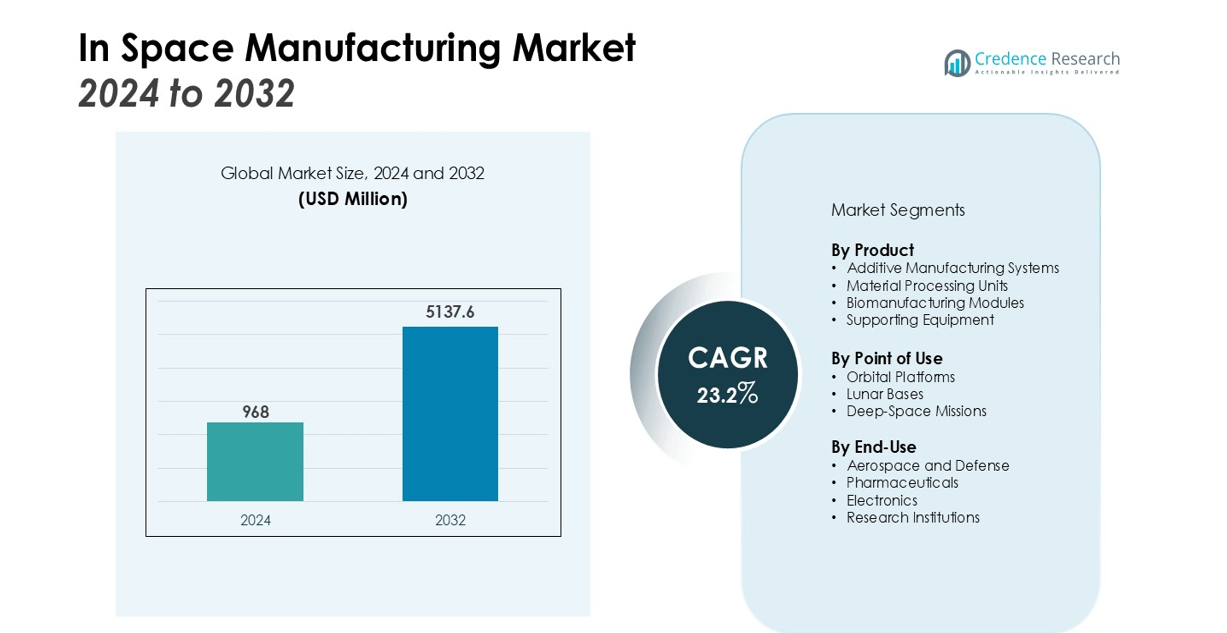Market Overview:
The In Space Manufacturing Market size was valued at USD 968 million in 2024 and is anticipated to reach USD 5137.6 million by 2032, at a CAGR of 23.2% during the forecast period (2024-2032).
| REPORT ATTRIBUTE |
DETAILS |
| Historical Period |
2020-2023 |
| Base Year |
2024 |
| Forecast Period |
2025-2032 |
| In-Space Manufacturing Market Size 2024 |
USD 968 million |
| In-Space Manufacturing Market, CAGR |
23.2% |
| In-Space Manufacturing Market Size 2032 |
USD 5137.6 million |
The in-space manufacturing market is gaining momentum as investments from governments and private enterprises in space exploration continue to rise. Expanding satellite deployments and breakthroughs in microgravity manufacturing are fueling demand. Companies are leveraging additive manufacturing, crystal growth, and advanced material production in orbit for applications in semiconductors, pharmaceuticals, and specialty alloys. Lower launch costs and the development of return-capable capsules further enhance feasibility and strengthen adoption.
North America dominates the market, supported by national space programs, strong commercial ventures, and advanced infrastructure. Asia-Pacific is recording the fastest growth, with countries like China and India accelerating efforts in space manufacturing. This expansion is driven by policy initiatives and rising involvement from private enterprises, highlighting the region’s growing role in global market development. Growing international collaborations and partnerships are also fostering technology transfer and accelerating commercialization opportunities.

Market Insights:
- The In Space Manufacturing Market was valued at USD 968 million and is projected to reach USD 5137.6 million by 2032, growing at a CAGR of 23.2%.
- Rising investments from government agencies and private enterprises are driving innovation and accelerating adoption of in-orbit manufacturing technologies.
- Expanding satellite deployments and demand for advanced materials such as alloys, crystals, and composites strengthen growth opportunities.
- Technological progress in microgravity manufacturing, including additive manufacturing and bio-production, is improving efficiency and creating high-value industrial applications.
- High initial costs, operational risks, and regulatory uncertainty remain key barriers that limit broader participation and slow adoption.
- North America leads with 46% share, supported by strong infrastructure, established space programs, and commercial ventures.
- Asia-Pacific holds 29% share, registering the fastest growth, while Europe with 19% share focuses on collaboration and sustainability to strengthen its role in global development.
Shape Your Report to Specific Countries or Regions & Enjoy 30% Off!
Key Player Analysis:
- Lockheed Martin Corporation
- Airbus SE
- Northcorp Grumma
- Allevi Inc
- Northcorp Grumman Corporation
- Astrobotic Technology, Inc.
- Le Verre Fluore Fiber Solutions
- Axiom Space, Inc.
- Echodyne Corporation
- Sierra Nevada Corporation
- Global Graphene Group, Inc. (G3)
Competitive Analysis:
The In Space Manufacturing Market is shaped by a competitive landscape that includes established aerospace companies, specialized space technology providers, and emerging startups. Leading players focus on research and development to expand capabilities in additive manufacturing, material processing, and biomanufacturing under microgravity conditions. It encourages partnerships with space agencies, private investors, and research institutions to accelerate deployment of advanced manufacturing systems. Companies are also investing in reusable launch systems and return-capable capsules to improve commercial viability and reduce costs. Strategic collaborations and joint ventures remain central to gaining a competitive edge, ensuring shared expertise and faster market entry. The emphasis on sustainable manufacturing practices and advanced infrastructure highlights the growing maturity of the competitive environment, while regional leaders continue to strengthen their dominance through policy support, innovation, and technology transfer. This evolving competitive dynamic is expected to define long-term growth in space-based industrial production.
Recent Developments:
- In August 2025, Astrobotic Technology, Inc. signed a Term Sheet with Norway’s Andøya Space to create a launch and landinging site for its Xodiac reusable rocket, planning for its first European launch campaign in 2026.
- In July 2025, Axiom Space, Inc. formed a partnership with Oakley to design and develop a cutting-edge visor system for future astronauts.
- In September 2025, Echodyne Corporation was selected to provide its MESA® radars for the Australian Defence Force counter-drone initiative, known as “Project Land 156”.
Report Coverage:
The research report offers an in-depth analysis based on Product, Point of Use, End-Use and Region. It details leading market players, providing an overview of their business, product offerings, investments, revenue streams, and key applications. Additionally, the report includes insights into the competitive environment, SWOT analysis, current market trends, as well as the primary drivers and constraints. Furthermore, it discusses various factors that have driven market expansion in recent years. The report also explores market dynamics, regulatory scenarios, and technological advancements that are shaping the industry. It assesses the impact of external factors and global economic changes on market growth. Lastly, it provides strategic recommendations for new entrants and established companies to navigate the complexities of the market.
Future Outlook:
- The In Space Manufacturing Market will expand as governments and private enterprises increase funding for orbital production.
- Companies will adopt advanced additive manufacturing systems to produce complex parts directly in orbit.
- Microgravity will enable the development of pharmaceuticals and crystals with higher precision and improved quality.
- It will support the aerospace and defense sector with lightweight structures that enhance mission efficiency.
- Return-capable capsules and reusable launch systems will improve cost efficiency and strengthen commercial adoption.
- Regional collaboration will grow, with North America leading innovation and Asia-Pacific accelerating capacity expansion.
- Europe will continue to focus on sustainable projects and collaborative ventures to enhance competitiveness.
- It will attract strong interest from electronics manufacturers producing fiber optics and semiconductors in orbit.
- International partnerships will increase, promoting knowledge transfer and driving faster commercialization of new technologies.
- The long-term outlook highlights self-sustaining ecosystems in space, supporting exploration, research, and industrial-scale production.








